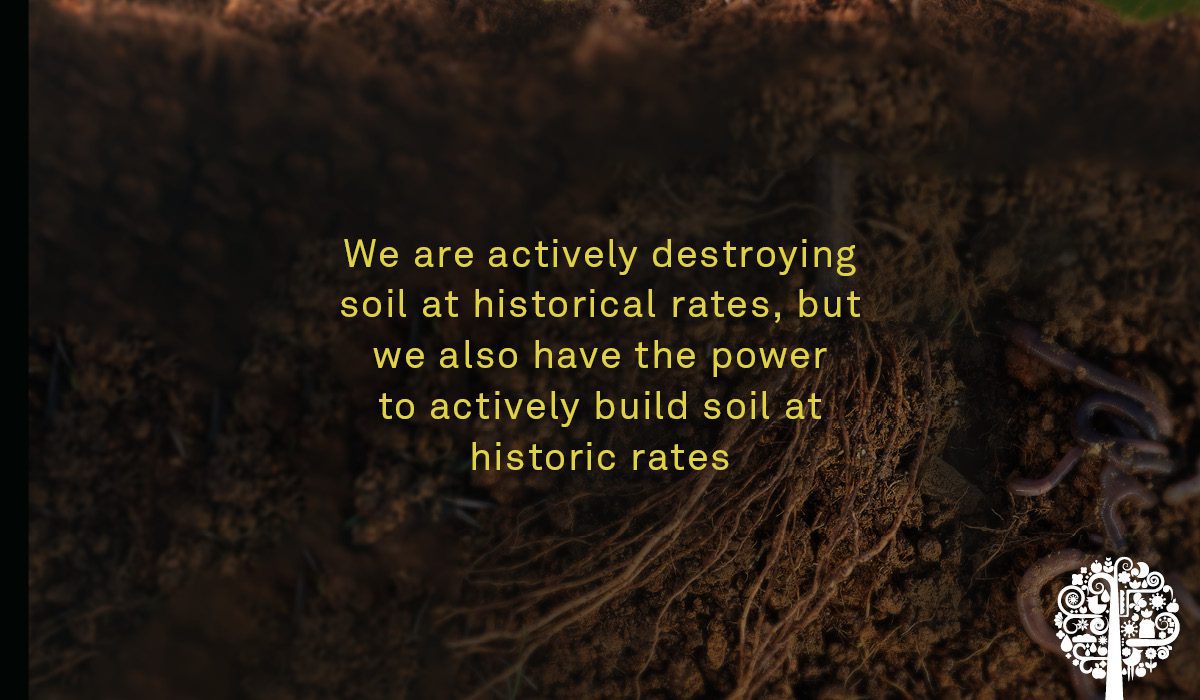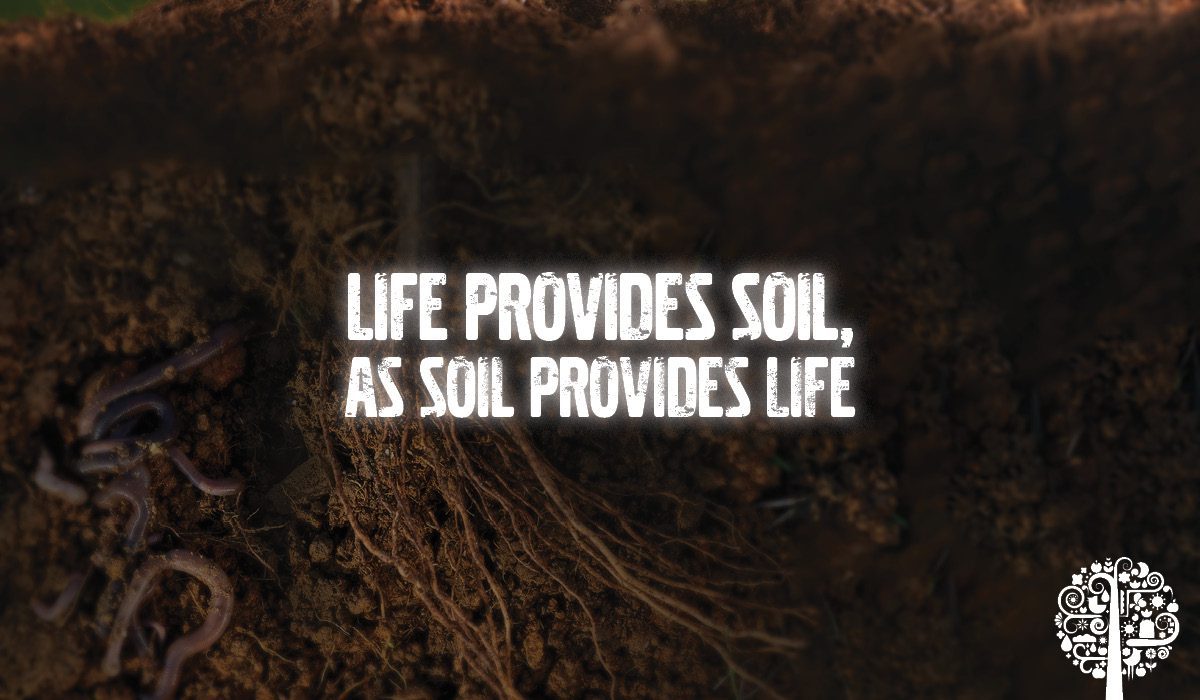What is “Living Soil”? It seems like a concept that has been gaining momentum in the 21st century. I won’t get into the dust bowl history and how “soil conservation” became a mainstay of conventional agriculture, although I encourage you to read up on it. I want to fast forward to a time when “Soil Conservation” still isn’t enough. It is not enough to conserve the soil we have left. We are actively destroying soil at historical rates, but we also have the power to actively build soil at historic rates. It can be disheartening to hear that it takes hundreds to thousands of years to create one inch of topsoil, and erosion and mediocre land stewardship can wash that away in a decade. This is only part of the soil’s truth. Sure, it takes rocks a long time to break down and weather and progress to a developed soil, but with human intervention, we can create environments that significantly speed up this process. The answer is right under our noses and already part of our everyday life. Compost! This is where soil comes to life. This is where we can each have an impact.
What About Soil?
Soil is a forgotten resource. Every day, we recycle plastic, paper, metals cans, etc., while we throw food in the garbage as if these scraps were not a recyclable product. Food is the easiest and least energy-intensive thing to recycle. Not only that, but it is a small act that can have an enormous impact. If you are defeated and don’t know how you can help save the world, start by saving the soil. The impacts are many, from recycling our food into fertilizer to reducing greenhouse gasses and increasing carbon sequestration. The soil is truly one of our most important ecological resources.

So what can each of us do on a small scale to make a big difference? How can one person or one household participate in this living soil revolution? When we are all so busy, living in cities, consuming products from all over the world, it seems impossible to change our entire existence.
We keep hearing things like permaculture, compost tea, ferments, Korean Natural Farming, closed-loop systems, regenerative, farm to table, and so on, but what does it mean in practice? How can we make a difference that feels functional and positive for us in our daily lives?
The answer is microorganisms, and there are many ways to accomplish this depending on your lifestyle and site limitations. Everyone can do it; you just need to find the version to fit your needs. Even if all you can do is bury the food scraps directly into the ground, or have a small worm compost bin under your sink, or a local green waste composter who will accept your yard waste, a little bit goes a long way.
There are two main concepts accepted when it comes to human-supported living soil development – aerobic and anaerobic microbial digestion. These organisms, either aerobic (requiring oxygen) or anaerobic (not requiring oxygen), break apart the cellulose in decaying plant cell walls, releasing the internal life force bound by those walls, making it available to the plants.
Let’s Talk Aerobic Techniques
Composting is simply creating the right balance of plant and/or animal materials that provide food, shelter, and moisture to microbes. This balance allows the microbial life cycle to kick start the decomposition process. Use plant matter, like grass clippings or wood chips, and animal manures, like chicken or even rabbit droppings. Finding the materials that are most easily accessible to you is the best way to dial in your compost recipe, building these necessary microbial populations.
It takes about three months to make finished compost, lightning speed compared to the timeline when unsupported by humans. Compost becomes a source of aerobic microorganisms as it provides all the requirements for life – food, shelter, moisture, and warmth.
Actively Aerated Compost Tea (AACT), popularised by Dr. Elaine Ingham, is a style of breeding and amplifying aerobic microorganisms to be added to soils for improved soil health and breathes life into our tired and degraded soils. Finished compost is where we source the microbes; the tea we brew is meant to amplify them or increase their populations through reproduction. The more aerobic microbes, the better!
Now Let’s Talk Anaerobes
The other form of microbial amplification is done using anaerobic microorganisms, mainly bacterial. Korean Natural Farming, popularised by Dr. Cho, uses intentional anaerobic fermentation to break down the cell walls and release the life force from the plants. Bokashi, popularised by Dr Teuro Higa, out of Okinawa, Japan, is another anaerobic fermentation technique that uses all food and animal waste forms in its rapid breakdown process. Even crazier– static composting; a way to decompose animal remains and other fat and protein-based materials.

An essential aspect of anaerobic fermentation is that it is controlled and intentional rather than accidental. We are not talking about an intended aerobic compost pile that goes bad due to lack of oxygen, or you would be breeding harmful microbes that you do not want to add to your system. Those anaerobes will often kill your garden plants.
The anaerobic fermentation process is specifically focused on brewing out this other type of beneficial organism to reap the benefits of what they excrete – lactic acids – which help keep pathogenic organisms at bay and a myriad of other benefits. We simply use fermentation to harness these specialized organisms and the exudates they release and apply them to our aerobic soil system. We generally think of anaerobic conditions as bad and phytotoxic. However, it’s important to note that many anaerobes are necessary and beneficial. This is why it is crucial to be intentional about the fermentation method you are using and that you are curating the benefits rather than the detriments.
Both aerobic and anaerobic decomposition use the natural microbes already floating around in our environment to facilitate the composting process. All we do is add the” feedstock” and optimal growing conditions to encourage them to reproduce and make more of themselves. We then take this concoction of microbial goodness and add it to the soil to increase nutrition, water holding capacity, carbon sequestration, and disease-fighting power. When this happens, our soil is truly “Alive”.
Clean Soil Is Essential
Our world revolves around soil biology. Learning to harness these forces and contribute positively to our world, even at the smallest scale, really matters. Clean soil and water are the fundamental sources of life on this planet, without which none of us would exist. Just as we can’t survive without our gut flora, soil cannot live without its flora. Let’s help nature speed up this laborious process and do our part to return the nutrients and carbon from our food back to the earth.